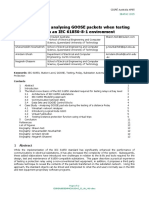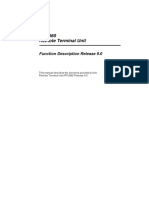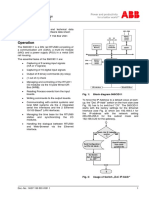RTU560 Interface
RTU560 Interface
Uploaded by
hare ramCopyright:
Available Formats
RTU560 Interface
RTU560 Interface
Uploaded by
hare ramCopyright
Available Formats
Share this document
Did you find this document useful?
Is this content inappropriate?
Copyright:
Available Formats
RTU560 Interface
RTU560 Interface
Uploaded by
hare ramCopyright:
Available Formats
RTU560
Connections and Settings
DIN Rail RTU 560CIG10
Application, characteristics and technical data
have to be taken from the hardware data sheet:
560CIG10 1KGT 150 719
Operation
The 560CIG10 is a DIN rail RTU560 consisting of
a communication unit (CMU), a multi-I/O module
(MIO) and a power supply (PSU) in a metal DIN
rail housing.
The essential tasks of the 560CIG10 are:
Capturing of 8 analog input signals
(mA or V signals)
Capturing of 16 digital input signals
Output of 8 binary commands (by relay)
(1 out of n) check
Fig. 1: Block diagram 560CIG10
Managing and controlling of the RTU211
I/O modules via the10 pole Wired-OR-Bus
To force the IP-Address to a default value at start-
(WRB).
up, the “Def. IP-Addr” switch on the front side (see
Reading Process events from the input Fig. 16) has to be switched “ON”. The 560CIG10
boards. starts with the factory settings for the Ethernet
Interface (see Fig. 2) which are 192.168.0.1 for
Writing commands to the output boards.
the IP-address with the network setting
Communicating with control systems and 255.255.255.0 for the subnet mask and
local MMI systems via the 3 integrated se- 192.168.0.20 for the gateway.
rial line interfaces and the Ethernet
10/100 BaseT LAN interface.
Managing the time base for the RTU560
station and synchronizing the I/O mod- Switch „Def. IP- Address“
ules. ON position OFF
?
Handling the dialogue between RTU560
and Web-Browser via the Ethernet inter-
face. Read IP address
Send Configuration from confi-
to RTU 192.168.0.1 guration file
Set Switch
„Def. IP-Address“
to „OFF“
Fig. 2: Usage of Switch „Def. IP-Addr“
Doc.-No.: 1KGT 150 720 V006 1 1
RTU560
Connections and Settings DIN Rail RTU 560CIG10
CPA Interface CP1 and CP2 Interface
The CPA Interface is available on the RJ45 con- The CP1 and CP2 Interfaces USART (universal
nector. It can interface RS485 signals. The bus is synchronous/asynchronous receiver/transmitter)
terminated by a 1 kΩ resistor. are available on the RJ45 connectors. They can
The settings have to be done by the RTUtil560 Interface RS232C signals. On both Interfaces
different UART based protocol types can be used.
configuration tool. The signals are used according
to Tab. 1 The signals are used according to Tab. 2.
CPA Interface RS485 Mode CP1 and CP2 Interface RS232C Mode
Pin Signal Pin Signal Input/Output
1 - Not used 1 DCD Input
2 TA Data - 2 RxD Input
RJ45 RJ45
3 TB Data + 3 TxD Output
Rx 1 Rx 1
4 - Not used 4 DTR Output
Tx 8
5 GND Signal Ground 5 GND Signal Ground Tx 8
Jack
Jack
6 - 6 - Not used
7 - Not used 7 RTS Output
8 - 8 CTS Input
Tab. 1: CPA Interface RS485 Mode Shield Connected with
housing
Tab. 2: CP1- and CP2 Interface RS232C Mode
2 Doc.-No.: 1KGT 150 720 V006 1
RTU560
Connections and Settings DIN Rail RTU 560CIG10
Ethernet Interface Main Power Supply (MPS)
The Ethernet Interface is available on a RJ45 The supply voltage for the 560CIG10 is 24VDC.
connector and supports different functions: The connector X4 consists of a 3 pole pluggable
screw-terminal 5,08mm (see Tab. 4, Fig. 14 and
Webserver-diagnostic with download of
Fig. 15). The maximum input power is 67 Watt.
configuration files and firmware
TCP/IP based protocols IEC 60870-5-
104, DNP3, … Main Power Supply
Integrated HMI Pin DC-IN
The signals are used according to Tab. 3 1 Vin (+)
2 Vin (-)
Ethernet Interface 3 Earth
Tab. 4: 3 Pole Power Connector
Pin Signal Input/Output
1 TD + Output In some cases an external potential
isolation for the DC-Input is neces-
2 TD - Output
! sary. This can be done e.g. by a
3 RD + Input power supply unit 560PSU40/41
RJ45
4 - Not used
Lnk 1
5 - 560CIG10 Earthing
8
Act On the strength of safety and EMC protection it is
6 RD - Input
Jack
important to make a connection as short as possi-
7 - Not used
ble to a system earth (may be DIN-rail or mount-
ing plate). An ordinary 1.5mm2 multi-core wire
8 - (green/yellow) can be used and should not ex-
ceed a length of 100 cm (39 inch). Pin X4-3 of the
Shield Connected with 3 pole DC-In connector is the earth-pin (see Tab.
housing 4). The protection earth must be connected there.
Tab. 3: Ethernet Interface The power supply terminal X4-2 (Vin -) is internal
connected with the housing potential by jumper
X9 (see Fig. 7 or Fig. 8).
IO-Bus
The connection to the local I/O boards is done by
a 20 pole female connector. The connection to the
serial peripheral bus (Wired OR-Bus) is done by a
20 pole male connector (see Fig. 15 IO-BUS). The
package of the 23AD62 or 211ADD52 module
includes one ribbon cable with the length of 19cm
(7,5inch). The ribbon cable should not exceed a
length of 50cm (20inch).
Attention: It is not allowed to pull
! or to plug the 20 pole ribbon
cable during the operation pro-
cess.
Doc.-No.: 1KGT 150 720 V006 1 3
RTU560
Connections and Settings DIN Rail RTU 560CIG10
Signalling Firmware Version
The LED’s of the 560CIG10 are controlled by the The current firmware version will be delivered on
RTU560 firmware (except Tx and Rx). For the a CompactFlashTM memory card. A new firmware
definition and operation of the LED “ERR" please file can be loaded via the Web diagnostic tool into
refer to the release specific function description. the removable CompactFlashTM memory card.
The connector embedded LEDs “Tx” and “Rx” are
directly connected to the receiver/transmitter of
the communication line. The LEDs “Act" and “Lnk” The 560CIG10 will be delivered without a
are directly connected to the Ethernet-controller. CompactFlashTM memory card.
Tab.5 describes the system LEDs of the
560CIG10. For changing the CompactFlashTM memory card
the right side of the housing has to be opened
(see Fig. 16).
LED Colour Meaning
ERR (1x) red Warning / Error
TM
For changing the CompactFlash
Tx (4x) green Transmit data (CP1, 2, A) ! card follow the instructions below:
Rx (4x) green Receive data (CP1, 2, A)
Lnk (2x) yellow Ethernet Link 1. Disconnect the power-supply of the
560CIG10.
Act (2x) green Ethernet Activity 2. Take care of ESD protection before
opening the 560CIG10 housing.
IO-Bus (1x) green Serial Peripheral Bus
3. Open the 4 screws on the right side of
PF (1x) red One of the output voltage the housing (see Fig. 16).
is fail 4. Pull or plug only the CF-card. Don’t
touch other components.
RUN (1x) green The CMU is reachable
via Ethernet 5. Close the housing before the power-
supply is connected to the 560CIG10
RUN (1x) yellow The firmware is running
but not reachable via
Ethernet
RUN OFF No firmware is running
Def. IP- (1x) red The default IP-address is
Addr active
BI (16x) yellow Signals the binary Input-
Units status
BO (8x) yellow Signals the binary Out-
Units status
Tab. 5: Meaning of LEDs
Doc.-No.: 1KGT 150 720 V006 1 4
RTU560
Connections and Settings DIN Rail RTU 560CIG10
Input / Output Binary Input
The 16 binary inputs of the 560CIG10 are
The multi-I/O-part of the 560CIG10 board scans
grouped into two groups of 8 inputs each (see Fig.
analog and digital signals and prepares them for
15 and 17). Each group has its own common re-
the RTU560 on the basis of predefined parame-
turn.
ters. The board is available in two versions:
The 560CIG10 board scans all 16 binary inputs
R0001: 24 ... 60 V DC process voltage
every millisecond and prepares them for the
R0002: 110 / 125 V DC process voltage RTU560 on the basis of predefined parameters.
In general the 560CIG10 board can process the The board 560CIG10 supports:
following signals:
16 single indications with time stamp
Max. 8 analog inputs
8 double indications with time stamp
Max. 16 binary inputs
2 digital measured values with 8-bit
Max. 8 binary outputs
1 digital measured value with 16-bit
In addition the 560CIG10 is equipped with an (1
out of n) check circuit for command output. 16 pulse counters
channel 1 up to 16 kHz count events,
all others up to 120 Hz count events
Processing functions (on the lower eight input channels)
Analog Input Binary Output
Each analog input can process the following func- The 560CIG10 has 8 binary output channels
tions (see Fig. 15 and 17): equipped with relays. The outputs are isolated
from the electronic part by means of optocoupler.
Zero point monitoring
Each output channel has its own return.
Switching recognition
The 560CIG10 can process the following com-
Smoothing mands:
Threshold value monitoring of absolute val- Commands with 1 or 2 pole connection
ue or with accumulation and periodic back- without (1 out of n) check
ground transmission
Commands with 1 or 2 pole connection
Input signal conversion with (1 out of n) check
The 560CIG10 board transmits the measured Regulation commands (1 and 2 pole)
value with 12-bit plus sign. The scaling for the Setpoint commands (8 bit)
telecontrol transmission protocol presentation is
done by the CMU. Bit string output (1, 2 or 8 bit)
(1 out of n) check circuit
Two transistor outputs are available to connect
two external relays X1-4 and X1-5 for the inte-
grated (1 out of n) check circuit of the 560CIG10.
The check circuit can be used also for additional
output boards.
The resistor measurement range for the integrat-
ed (1 out of n) check circuit can be configured
between 100Ω and 10kΩ in steps of 10Ω by the
RTUtil560 configuration tool.
Doc.-No.: 1KGT 150 720 V006 1 5
RTU560
Connections and Settings DIN Rail RTU 560CIG10
Settings CH1 S1-1 S1-2
Off Off 2V, 20V (bipolar)
Analog Input
On Off 2mA, 5mA, 10mA (bipolar)
Input Signal Range Off On 20mA, 40mA (bipolar)
The voltage/current measuring range can be in- CH2 S1-3 S1-4
dependently configured for each of the channels
by switches (DIP-Switches) S1 and S2 (see Fig. Off Off 2V, 20V (bipolar)
14). On Off 2mA, 5mA, 10mA (bipolar)
X3-1, X3-3, X3-5 Off On 20mA, 40mA (bipolar)
X3-7, X3-9
X7-7, X7-5, X7-3 + CH3 S1-5 S1-6
Shunt
Resistor Off Off 2V, 20V (bipolar)
DIP-Switch On Off 2mA, 5mA, 10mA (bipolar)
X3-2, X3-4, X3-6 -
X3-8, X3-10 Off On 20mA, 40mA (bipolar)
X7-6, X7-4, X7-2
CH4 S1-7 S1-8
Fig. 3: Analog Input 560CIG10 Off Off 2V, 20V (bipolar)
On Off 2mA, 5mA, 10mA (bipolar)
The measuring range for the channels 1 to 5
(X3-1 to X3-/10) can be configured with S1. The Off On 20mA, 40mA (bipolar)
measuring range for the channels 6 to 8 (X7-7 to CH5 S1-9 S1-10
X7-2) can be configured with S2.
Off Off 2V, 20V (bipolar)
The configuration of the switches S1 and S2 have
to be assumed into the RTUtil560 configuration On Off 2mA, 5mA, 10mA (bipolar)
tool. Off On 20mA, 40mA (bipolar)
The switch configuration for the different measur- CH6 S2-1 S2-2
ing ranges is shown in Tab. 6.
Off Off 2V, 20V (bipolar)
On Off 2mA, 5mA, 10mA (bipolar)
The default configuration of Off On 20mA, 40mA (bipolar)
! the Analog Inputs is set to
CH7 S2-3 S2-4
measuring voltages!
Off Off 2V, 20V (bipolar)
On Off 2mA, 5mA, 10mA (bipolar)
Off On 20mA, 40mA (bipolar)
CH8 S2-5 S2-6
Off Off 2V, 20V (bipolar)
On Off 2mA, 5mA, 10mA (bipolar)
Off On 20mA, 40mA (bipolar)
Tab. 6: Analog Input Measurement Range
Configuration
6 Doc.-No.: 1KGT 150 720 V006 1
RTU560
Connections and Settings DIN Rail RTU 560CIG10
Configuring the line frequency Connections
The information about the line frequency is re- Power Supply
quested for the A/D conversion. The configured The power supply for the 560CIG10 R0001 (see
line frequency is valid for all 8 channels and will Fig. 6) and for the 560CIG10 R0002 (see Fig. 8)
be configured by a parameter at the RTUtil560 will be connected to screw terminal X4-1 (+) and
configuration tool. X4-2 (-) and will be relayed internal to the power
supply unit board.
Line fre- Conversion time Complete The protection earth must be connected to screw
quency per input [ms] scan cycle terminal 4-3 (see Fig. 14) for both 560CIG10 revi-
[Hz] [ms] sions.
60 50.0 400 The power supply terminal X4-2 (-) is internal
50 60.0 480 connected with the housing potential by jumper
X9 (see Fig. 7 and Fig.8).
16.6 180.0 1440
In rare cases (e.g. when grounding signal zero to
Tab. 7: Configuration of line frequency Vin (+)) the jumper X9 has to be removed. Open-
ing of the housing is done in the same way as for
In addition max. two channels can operate at the changing the CF card but the opposite side has to
fast-scan mode (the other channels will be deac- be open.
tivated at the fast-scan mode). For the fast-scan
mode following values are valid:
Line fre- Conversion time Complete
quency per input [ms] scan cycle
[Hz] [ms]
60 50.0 100
50 50.0 100
16.6 100.0 200
Tab. 8: Configuration of line frequency at
fast-scan mode
Factory calibration Fig. 4: Placement of X9 (topside PCB inside
housing)
On-site calibration of the A/D converter is not
necessary. Analog Input
The 560CIG10 is calibrated for all channels and The process signals will be connected to screw
measuring ranges at the factory. During the cali- terminal X3-1 to X3-10 (channel 1 to 5) and X7-7
bration the firmware calculates a rating value per to X7-2 (channel 6 to 8).
measuring range and channel and stores this
rating value in an EEPROM. The analog inputs are designed for current range
from 2mA, 5mA, 10mA, 20mA to 40mA (bipolar)
Binary Input and voltage range from 2V to 20V (bipolar).
The 560CIG10 has no switch or jumper for the Binary Input
binary input part.
The process signals will be connected to screw
Binary Output terminal X5-19 to X5-12 (channel 1 to 8) and X5-8
to X5-1 (channel 9 to 16). The common return for
The output solid state relay circuit (24 VDC) is the first eight channels is screw terminal X5-11,
monitored during the output process. for the last eight channels X5-9.
Doc.-No.: 1KGT 150 720 V006 1 7
RTU560
Connections and Settings DIN Rail RTU 560CIG10
Binary Output
The process signals will be connected to screw ALARM – Output (ALR)
terminal X2 (channel 1 to 8), see Fig. 14. If an error condition occurs in the RTU the ALR-
Figure 10 shows the one pole connection. output will be switched. RTU error conditions have
to be taken from the function description of the
For a 2 pole connection (see Fig. 11 and Fig. 12)
RTU560 releases.
two internal relays of the 560CIG10 are used (e.g.
The alarm output is a normal close contact which
C1 and C3 for a double command output, and C2
will be opened if alarm status is off.
and C4).
(1 out of n) check circuit
For the (1 out of n) check two external relays are Alarm status: on contact closed
used, which will be connected to X1-4 (GO relay Alarm status: off contact open
R9, optional) and X1-5 (measurement relay R10).
The coil voltage of the relay is 24V. X1-6 (+) and
X1-7 (-) is the input for the integrated check cir- X6-1
cuit. The external relays are not scope of
delivery! X6-2
ABB recommend following relay:
Finder, miniature-relay
! (55.32.9.024.0090, 24VDC, 2W, 10A)
Fig. 6: ALARM-Output
The measuring relays are switched on and the
configured delay time has to be expire before the
actual measuring starts.
Process Voltage (UP)
The process voltage (see Fig. 14) will be connect- Signaling
ed to screw terminal X1-3 (+) and X1-2 (-).
The function earth can be connected to screw Analog Input
terminal X1-1 (PE).
The analog input part of the 560CIG10 has no
Main Supply Supervision (MSS) external signaling.
By using an AC-power supply unit (e.g. 23VG23)
with integrated battery load control a MSS is Binary Input
necessary. The MSS shows the status of the bat- 16 yellow LED’s are mounted on the front side of
tery, cabling the 560CIG10 (see Fig. 16), showing the actual
and fuse protection. state of the binary inputs.
Binary Output
8 yellow LED’s are mounted on the front side of
the 560CIG10 (see Fig. 16), showing the actual
state of the binary output channels.
Fig. 5: Main Supply Supervision (MMS)
8 Doc.-No.: 1KGT 150 720 V006 1
RTU560
Connections and Settings DIN Rail RTU 560CIG10
Fig. 7: Power Supply 560CIG10 R0001
Fig. 8: Power Supply 560CIG10 R0002
Doc.-No.: 1KGT 150 720 V006 1 9
RTU560
Connections and Settings DIN Rail RTU 560CIG10
Fig. 9: Binary Input 560CIG10
C1 C8
…..
GO
Relay
X2-1 X2-2 X2-15 X2-16
R1 ….. R8
+
UP
-
1 pole Connection
Fig. 10: Binary Output 560CIG10, single command, 1 pole connection
10 Doc.-No.: 1KGT 150 720 V006 1
RTU560
Connections and Settings DIN Rail RTU 560CIG10
C1 C2
GO
Relay
X2-1 X2-2 X2-3 X2-4
R1 +
UP
-
Single Command
2 pole Connection
Fig. 11: Binary Output, Single Command, 2 pole connection
C1 C2 C3 C4
GO
Relay
X2-1 X2-2 X2-5 X2-6
X2-3 X2-4 X2-7 X2-8
ON OFF
-
UP
+
Double Command 2 pole Connection
Fig. 12: Binary Output, Double Command, 2 pole connection
Doc.-No.: 1KGT 150 720 V006 1 11
RTU560
Connections and Settings DIN Rail RTU 560CIG10
Fig. 13: Binary Output, (1 out of n) check, single command, 1 pole connection
Fig. 14: Placement of the terminal screws and switches
12 Doc.-No.: 1KGT 150 720 V006 1
RTU560
Connections and Settings DIN Rail RTU 560CIG10
Settings
The settings of the Ethernet Interface are:
Hardware settings and operation of the communi-
cation Interfaces of the 560CIG10 and IO-settings Node name
are carried out with the RTUtil560 configuration
IP address
tool. For the configuration procedure of the com-
munication Interfaces and the IO-Bus, please Subnet mask
refer to the RTUtil560 user guide.
Default gateway
The following parameters have to be defined for
all protocols: Routing information
Baudrate: 50 to 19 200 baud Number of the host Interfaces.
Modem control:
Direct link (TxD/RxD only)
WT link full duplex (560FSM10/11 no
handshake)
WT link half duplex (560FSM10/11 with
RTS / DCD)
Dial up (external modem without hand-
shake, without RTS / CTS)
Loop switch unit (RP570/71 Host Inter-
face only)
Link with collision avoidance (TxD, RxD,
DCD, without handshake (DNP 3.0 only)
Doc.-No.: 1KGT 150 720 V006 1 13
RTU560
Connections and Settings DIN Rail RTU 560CIG10
Fig. 15: Top side of 560CIG10 housing
screws
Fig. 16: Front and right side of 560CIG10 housing screws
Fig. 17: Bottom side of 560CIG10 housing
14 Doc.-No.: 1KGT 150 720 V006 1
RTU560
Connections and Settings DIN Rail RTU 560CIG10
Note:
We reserve the right to make technical changes or modify the contents
of this document without prior notice. With regard to purchase orders,
the agreed particulars shall prevail. ABB AG does not accept any
responsibility whatsoever for potential errors or possible lack of infor-
mation in this document.
We reserve all rights in this document and in the subject matter and
illustrations contained therein. Any reproduction, disclosure to third
parties or utilization of its contents - in whole or in parts - is forbidden
without prior written consent of ABB AG.
Copyright© 2013 ABB
All rights reserved
Doc.-No.: 1KGT 150 720 V006 1 15
You might also like
- 09 - 1 RTU500 End-To-End Cyber SecurityDocument25 pages09 - 1 RTU500 End-To-End Cyber SecuritybzyNo ratings yet
- 08 RTU560 SCADA-Functions MonitorDir EDocument29 pages08 RTU560 SCADA-Functions MonitorDir EngocanhvyNo ratings yet
- Setting PC Tool: Instruction ManualDocument22 pagesSetting PC Tool: Instruction ManualminhchiNo ratings yet
- Abb Rtu560 PDFDocument2 pagesAbb Rtu560 PDFRidzky AryaNo ratings yet
- Abb Ag: Remote Terminal Unit Onnections and Settings DIN Rail RTU 560CIG10Document16 pagesAbb Ag: Remote Terminal Unit Onnections and Settings DIN Rail RTU 560CIG10Cosmic Garash 2No ratings yet
- Rtu560 CMR02Document4 pagesRtu560 CMR02hemsabhati0% (1)
- Communication Unit 560CMR02 Communication Unit 560CMR02: RTU560 Product Line RTU560 Product LineDocument4 pagesCommunication Unit 560CMR02 Communication Unit 560CMR02: RTU560 Product Line RTU560 Product LineHammad8No ratings yet
- Data Sheet: Communication Unit 560CMR01Document5 pagesData Sheet: Communication Unit 560CMR01Mohammed MostefaiNo ratings yet
- Operation: Connections and Settings Communication Unit 560CMU02 R0001Document4 pagesOperation: Connections and Settings Communication Unit 560CMU02 R0001Cosmic Garash 2No ratings yet
- 10 - 3 RTU560 - PLC - Engineering - EDocument40 pages10 - 3 RTU560 - PLC - Engineering - EbzyNo ratings yet
- 10 - 1 RTU560 - PLC - IntroductionDocument42 pages10 - 1 RTU560 - PLC - IntroductionbzyNo ratings yet
- RTU500 Series Review and News - UAE Dec.2013Document38 pagesRTU500 Series Review and News - UAE Dec.2013T Dung LuNo ratings yet
- Part Z - IEC-104Document22 pagesPart Z - IEC-104Lazhar ZahiNo ratings yet
- 00 E560 SD R 9 0Document116 pages00 E560 SD R 9 0ptheabstractNo ratings yet
- E560 DNP3 Host R13Document60 pagesE560 DNP3 Host R13mkvaisakhNo ratings yet
- 530ADD01 DS enDocument4 pages530ADD01 DS enHatem LaadhariNo ratings yet
- Abb Rtu560 SeriesDocument8 pagesAbb Rtu560 SeriesMirza HamedNo ratings yet
- HMI User GuideDocument34 pagesHMI User GuidePatel AshokNo ratings yet
- GooseDocument12 pagesGoosesteve_osullivanNo ratings yet
- 1MRG014136 B en IET600 Integrated Engineering Tool - IntroductionDocument64 pages1MRG014136 B en IET600 Integrated Engineering Tool - Introductionkass_ecs100% (1)
- Create A New Project Select Max No of Character As You WantDocument51 pagesCreate A New Project Select Max No of Character As You WantSalvador Fayssal100% (2)
- 10 - 2 RTU560 - PLC - OverviewDocument24 pages10 - 2 RTU560 - PLC - OverviewbzyNo ratings yet
- Sicam Pas CC V7 0 SP1 PDFDocument2 pagesSicam Pas CC V7 0 SP1 PDFHamidreza Moaddeli50% (2)
- RTU560 EnglishDocument16 pagesRTU560 EnglishrhomadonaNo ratings yet
- E560 IEC61850 SubDocument42 pagesE560 IEC61850 SubHubert Maraza JaliriNo ratings yet
- 09 1 Default IP Address EDocument12 pages09 1 Default IP Address EFinet CyrilleNo ratings yet
- Step by Step For Excel Import IN Rtutil NT SoftwareDocument46 pagesStep by Step For Excel Import IN Rtutil NT SoftwareSalvador FayssalNo ratings yet
- IEC 61850 Server Configuration Tool Users GuideDocument136 pagesIEC 61850 Server Configuration Tool Users GuideJuan PavezNo ratings yet
- E560 23be23 DSDocument4 pagesE560 23be23 DSSalvador FayssalNo ratings yet
- A - STCE - RTU HW Description Ed.1.1Document75 pagesA - STCE - RTU HW Description Ed.1.1Jung Boo JangNo ratings yet
- Reliable Solutions For Transmission and Sub-Transmission: RTU560 Product LineDocument2 pagesReliable Solutions For Transmission and Sub-Transmission: RTU560 Product Lineluhusapa-1No ratings yet
- RTU560 Remote Terminal Unit RTUtil560 UsDocument134 pagesRTU560 Remote Terminal Unit RTUtil560 UsAjay SinghNo ratings yet
- RTUtil 560 Application PDFDocument21 pagesRTUtil 560 Application PDFGilbert H. Quiroga G.100% (1)
- E560 23be50 DSDocument4 pagesE560 23be50 DSSalvador FayssalNo ratings yet
- Siemens S7 1200 Ethernet PDFDocument13 pagesSiemens S7 1200 Ethernet PDFStephen BlanchardNo ratings yet
- E560 Cmu05 DSDocument4 pagesE560 Cmu05 DSJoao SantosNo ratings yet
- Rtu560 SD R6Document112 pagesRtu560 SD R6rafaelmichelNo ratings yet
- Connections and Settings: Communication Unit 560CMU05Document5 pagesConnections and Settings: Communication Unit 560CMU05Mohammed MostefaiNo ratings yet
- 540CMD01 DS enDocument4 pages540CMD01 DS enFarukNo ratings yet
- IBox Configuration GuideDocument20 pagesIBox Configuration GuideleosenthilNo ratings yet
- SYS600 IEC 61850 System Design PDFDocument72 pagesSYS600 IEC 61850 System Design PDFMHEP_DANIELNo ratings yet
- RTU500 Series Remote Terminal Unit: Protocol Description Bidirectional Communication Interface With IEC60870-5-104Document68 pagesRTU500 Series Remote Terminal Unit: Protocol Description Bidirectional Communication Interface With IEC60870-5-104Bruno Nemer TattonNo ratings yet
- 4-SICAM SIAPP PresentationDocument99 pages4-SICAM SIAPP PresentationAnh Tuấn NguyễnNo ratings yet
- UCA and 61850 For Dummies V12Document37 pagesUCA and 61850 For Dummies V12Walter Andres Estevez VasquezNo ratings yet
- Iec 101 104Document22 pagesIec 101 104abdul nazeer100% (1)
- E560 FD Release 9 0 PDFDocument220 pagesE560 FD Release 9 0 PDFHatem LaadhariNo ratings yet
- 02 - Inps-Sa04 - Ied Engineering in Pcm600Document39 pages02 - Inps-Sa04 - Ied Engineering in Pcm600Hamed SANKARANo ratings yet
- 04 SAS With IEC 61850Document26 pages04 SAS With IEC 61850sridhar30481647No ratings yet
- l1 v4 10 Pacis GTW Overview C 03Document20 pagesl1 v4 10 Pacis GTW Overview C 03Aristides AnselmoNo ratings yet
- 1KGT030500R0001 Human Machine Interface Hmi For Rtu560 2 Ethernet Ports 4 Usb Ports Vga AudDocument2 pages1KGT030500R0001 Human Machine Interface Hmi For Rtu560 2 Ethernet Ports 4 Usb Ports Vga AudsavijolaNo ratings yet
- IEC ProtocolDocument20 pagesIEC ProtocolGhady AtefNo ratings yet
- E560 Cid11 CS PDFDocument15 pagesE560 Cid11 CS PDFmaximiliano tonsich100% (1)
- E560 CMG10 CSDocument8 pagesE560 CMG10 CSIlaiyaa RajaNo ratings yet
- 520AOD01 CS enDocument13 pages520AOD01 CS enBhageerathi SahuNo ratings yet
- Operation: Connections and Settings Communication Unit 560CMD11Document10 pagesOperation: Connections and Settings Communication Unit 560CMD11Tayeb AmeriNo ratings yet
- E560 Cmu05 CSDocument4 pagesE560 Cmu05 CSNyrlanNo ratings yet
- Abb Ag: OperationDocument4 pagesAbb Ag: OperationCosmic Garash 2No ratings yet
- Abb Ag: OperationDocument4 pagesAbb Ag: OperationNguyễn QuýNo ratings yet
- E560 Cmu80 CSDocument4 pagesE560 Cmu80 CSCosmic Garash 2No ratings yet
- 520CMD01 CS enDocument4 pages520CMD01 CS enDJ ThangNo ratings yet
- Field-Programmable Analog Arrays Enable Mixed-Signal Prototyping of Embedded SystemsDocument4 pagesField-Programmable Analog Arrays Enable Mixed-Signal Prototyping of Embedded Systemsrasyoung5302No ratings yet
- (M16c單晶片) (M306N5FCTFP) m306n5fctfpukDocument90 pages(M16c單晶片) (M306N5FCTFP) m306n5fctfpukzero cloudNo ratings yet
- Analog & Imaging IC Logic LSI: Semiconductor & Storage ProductsDocument28 pagesAnalog & Imaging IC Logic LSI: Semiconductor & Storage ProductsOlivier López ChNo ratings yet
- Sonix-Sn8p2711bsg C337794Document123 pagesSonix-Sn8p2711bsg C337794pyaesone789.mdyNo ratings yet
- PCM 2902Document33 pagesPCM 2902Antonio NovakNo ratings yet
- Confidential: Embedded ControllerDocument32 pagesConfidential: Embedded Controllerakhmad mukhsinNo ratings yet
- Laporan Simulasi: Praktikum Telekomunikasi DigitalDocument9 pagesLaporan Simulasi: Praktikum Telekomunikasi DigitalAchmad Farchan HadiNo ratings yet
- Precision Power Analyzer: Two Bandwidths SimultaneouslyDocument16 pagesPrecision Power Analyzer: Two Bandwidths SimultaneouslyRaymond TasiNo ratings yet
- JIF-2001A User Manual-V01Document57 pagesJIF-2001A User Manual-V01Sukri RasyidNo ratings yet
- Combina Audio Sony-Pmc-D-305 - 305L PDFDocument74 pagesCombina Audio Sony-Pmc-D-305 - 305L PDFcosaceaionNo ratings yet
- A Wireless PotentiostatDocument6 pagesA Wireless PotentiostatCarlos LopezNo ratings yet
- Magnetic Card Reader User Guide Handout Version 2.0 2023Document28 pagesMagnetic Card Reader User Guide Handout Version 2.0 2023gh0stNo ratings yet
- Group 2Document135 pagesGroup 2arpitshahNo ratings yet
- An Introduction To Digital CommunicationsDocument70 pagesAn Introduction To Digital Communicationsihab411No ratings yet
- ATJ2135Document111 pagesATJ2135souravsonar1997No ratings yet
- Aquacon SMARTPRO 8967P PDFDocument87 pagesAquacon SMARTPRO 8967P PDFReddy Manoj100% (1)
- Design and Construction of Internet of Things (IoT) Based Generator Monitoring SystemDocument11 pagesDesign and Construction of Internet of Things (IoT) Based Generator Monitoring SystemInternational Journal of Innovative Science and Research TechnologyNo ratings yet
- 2.co Deb2323 Basic MicrocontrollerDocument7 pages2.co Deb2323 Basic MicrocontrollerMOHAMAD NAZMI BIN NAJADI KPM-GuruNo ratings yet
- Gujarat Technological UniversityDocument2 pagesGujarat Technological UniversityTushar MaruNo ratings yet
- FJRX 84 EngDocument22 pagesFJRX 84 EngPalade LiviuNo ratings yet
- Lectronic LOW Orrector: HighlightsDocument2 pagesLectronic LOW Orrector: HighlightsSIG IDEASANo ratings yet
- Talking Volt MeterDocument9 pagesTalking Volt Meterudita10No ratings yet
- ECE 2001 Gate Question PapersDocument25 pagesECE 2001 Gate Question PapersprateekbaldwaNo ratings yet
- MOD 4017M 5c ModularProductsDocument94 pagesMOD 4017M 5c ModularProductslogin_nameNo ratings yet
- DSP Lab 2Document4 pagesDSP Lab 2fahadsaeed93No ratings yet
- Arduino & Iot Monitoring Baby System - SignedDocument10 pagesArduino & Iot Monitoring Baby System - Signedmbuja mbujaNo ratings yet
- A19303 Datasheet-3136922Document17 pagesA19303 Datasheet-3136922Oumaima OulhadjNo ratings yet
- TV/VCR Tuner Ic With DC/DC Converter: FeaturesDocument21 pagesTV/VCR Tuner Ic With DC/DC Converter: FeaturesEdsel SilvaNo ratings yet
- Final Pothole ReportDocument90 pagesFinal Pothole ReportRajasekar PanneerselvamNo ratings yet
- Blind Spot DetectionDocument13 pagesBlind Spot DetectionSHEPRYNo ratings yet

























































































